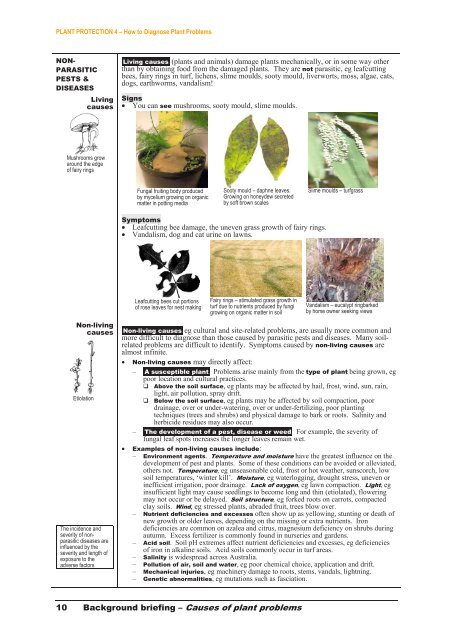PLANT PROTECTION 4
PLANT PROTECTION 4
PLANT PROTECTION 4
Create successful ePaper yourself
Turn your PDF publications into a flip-book with our unique Google optimized e-Paper software.
<strong>PLANT</strong> <strong>PROTECTION</strong> 4 – How to Diagnose Plant Problems<br />
NON-<br />
PARASITIC<br />
PESTS &<br />
DISEASES<br />
Living<br />
causes<br />
Mushrooms grow<br />
around the edge<br />
of fairy rings<br />
Non-living<br />
causes<br />
Etiolation<br />
The incidence and<br />
severity of nonparasitic<br />
diseases are<br />
influenced by the<br />
severity and length of<br />
exposure to the<br />
adverse factors<br />
Living causes. (plants and animals) damage plants mechanically, or in some way other<br />
than by obtaining food from the damaged plants. They are not parasitic, eg leafcutting<br />
bees, fairy rings in turf, lichens, slime moulds, sooty mould, liverworts, moss, algae, cats,<br />
dogs, earthworms, vandalism!<br />
Signs<br />
You can see mushrooms, sooty mould, slime moulds.<br />
Fungal fruiting body produced<br />
by mycelium growing on organic<br />
matter in potting media<br />
Sooty mould – daphne leaves.<br />
Growing on honeydew secreted<br />
by soft brown scales<br />
Symptoms<br />
Leafcutting bee damage, the uneven grass growth of fairy rings.<br />
Vandalism, dog and cat urine on lawns.<br />
Leafcutting bees cut portions<br />
of rose leaves for nest making<br />
Fairy rings – stimulated grass growth in<br />
turf due to nutrients produced by fungi<br />
growing on organic matter in soil<br />
10 Background briefing – Causes of plant problems<br />
Slime moulds – turfgrass<br />
Vandalism – eucalypt ringbarked<br />
by home owner seeking views<br />
Non-living causes. eg cultural and site-related problems, are usually more common and<br />
more difficult to diagnose than those caused by parasitic pests and diseases. Many soilrelated<br />
problems are difficult to identify. Symptoms caused by non-living causes are<br />
almost infinite.<br />
Non-living causes may directly affect:<br />
– A susceptible plant. Problems arise mainly from the type of plant being grown, eg<br />
poor location and cultural practices.<br />
Above the soil surface, eg plants may be affected by hail, frost, wind, sun, rain,<br />
light, air pollution, spray drift.<br />
Below the soil surface, eg plants may be affected by soil compaction, poor<br />
drainage, over or under-watering, over or under-fertilizing, poor planting<br />
techniques (trees and shrubs) and physical damage to bark or roots. Salinity and<br />
herbicide residues may also occur.<br />
– The development of a pest, disease or weed. For example, the severity of<br />
fungal leaf spots increases the longer leaves remain wet.<br />
Examples of non-living causes include:<br />
– Environment agents. Temperature and moisture have the greatest influence on the<br />
development of pest and plants. Some of these conditions can be avoided or alleviated,<br />
others not. Temperature, eg unseasonable cold, frost or hot weather, sunscorch, low<br />
soil temperatures, ‘winter kill’. Moisture, eg waterlogging, drought stress, uneven or<br />
inefficient irrigation, poor drainage. Lack of oxygen, eg lawn compaction. Light, eg<br />
insufficient light may cause seedlings to become long and thin (etiolated), flowering<br />
may not occur or be delayed. Soil structure, eg forked roots on carrots, compacted<br />
clay soils. Wind, eg stressed plants, abraded fruit, trees blow over.<br />
– Nutrient deficiencies and excesses often show up as yellowing, stunting or death of<br />
new growth or older leaves, depending on the missing or extra nutrients. Iron<br />
deficiencies are common on azalea and citrus, magnesium deficiency on shrubs during<br />
autumn. Excess fertilizer is commonly found in nurseries and gardens.<br />
– Acid soil. Soil pH extremes affect nutrient deficiencies and excesses, eg deficiencies<br />
of iron in alkaline soils. Acid soils commonly occur in turf areas.<br />
– Salinity is widespread across Australia.<br />
– Pollution of air, soil and water, eg poor chemical choice, application and drift.<br />
– Mechanical injuries, eg machinery damage to roots, stems, vandals, lightning.<br />
– Genetic abnormalities, eg mutations such as fasciation.






![[Compatibility Mode].pdf](https://img.yumpu.com/27318716/1/190x135/compatibility-modepdf.jpg?quality=85)










